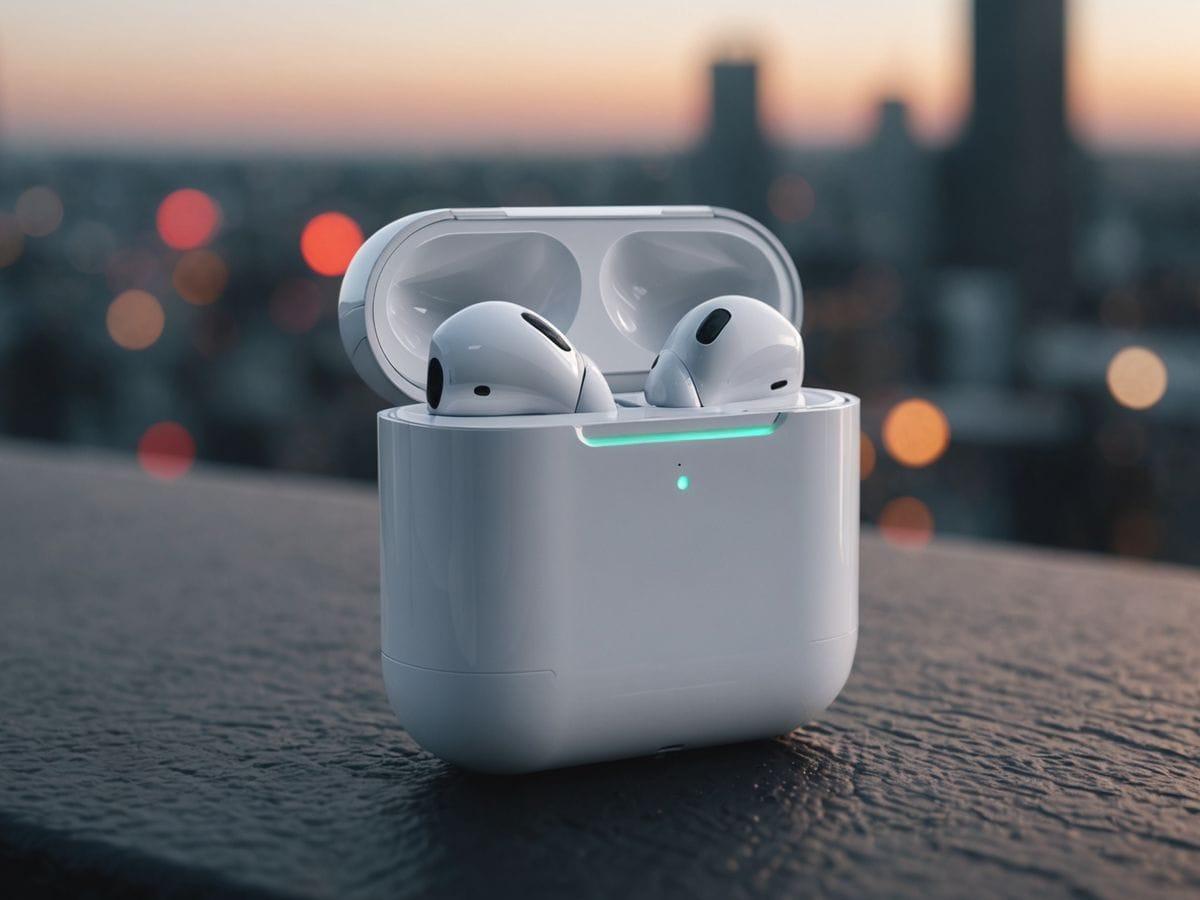The Apple AirPods prototype with cameras signifies a groundbreaking advancement in audio technology. With integrated cameras, these AirPods aim to enhance user interaction by leveraging Visual Intelligence, much like smart glasses, to provide contextual information. This innovative approach may redefine how users experience audio and interact with their environment, merging the worlds of audio and visual technology. As Apple continues to develop this exciting prototype, it sets the stage for a future where technology seamlessly blends into everyday life.
| Key Point | Details |
|---|---|
| Apple AirPods Prototype Development | Apple is developing a prototype of AirPods with built-in cameras, aiming for a potential future release. |
| Integration of Visual Intelligence | The AirPods may feature Visual Intelligence to help users understand their environment and interact seamlessly with Siri. |
| Enhanced Spatial Audio | Cameras could improve spatial audio experiences by enhancing directional sound based on user movement. |
| Anticipated Timeline | The new AirPods prototype with cameras might not be launched until 2027, potentially alongside smart glasses. |
The Apple AirPods prototype with cameras has sparked immense curiosity among tech enthusiasts and industry insiders alike. According to Bloomberg’s Mark Gurman, this innovative development is not set to debut with the upcoming AirPods Pro 3, yet it showcases Apple’s ambitious vision for the future of audio technology.
Integrating features such as Visual Intelligence, these advanced AirPods could revolutionize the way users interact with their surroundings, offering seamless connectivity and information retrieval. Additionally, the potential for enhanced spatial audio experiences and in-air gesture control positions this product as a frontrunner in the evolution of smart wearables, akin to smart glasses.
As Apple continues to push the boundaries of technology, the implications of AirPods equipped with cameras could redefine user engagement in the digital landscape.
The upcoming iteration of Apple’s wireless earbuds, referred to as the AirPods prototype with integrated cameras, is poised to change how users experience audio and visual interactions.
This next-gen device aims to incorporate features reminiscent of smart glasses, enabling users to engage with their environment like never before. By leveraging Visual Intelligence, these innovative earbuds could provide context-aware information, enhancing everyday tasks and media consumption.
Furthermore, with the potential for spatial audio enhancements and intuitive in-air gesture controls, the AirPods could seamlessly blend audio experiences with augmented reality capabilities. As technology advances, this prototype signifies Apple’s commitment to creating a more immersive and interconnected user experience.
Future of Audio: Apple AirPods Prototype with Cameras
Apple is pushing the boundaries of audio technology with its upcoming AirPods prototype featuring built-in cameras. This innovative approach signals a shift in how users will interact with audio devices, intertwining visual intelligence with sound.
By integrating cameras, the AirPods will not only enhance audio experiences but also provide contextual awareness, allowing users to engage with their environment in entirely new ways. This development reflects Apple’s commitment to not just being a leader in audio technology but also in the realm of augmented reality and AI.
The inclusion of cameras in the AirPods raises intriguing possibilities. Users could gain insights about their surroundings, facilitating interactions that go beyond listening. Imagine asking Siri about nearby landmarks or events without needing to check your phone. This seamless integration may redefine how we perceive audio devices, transforming them into multifaceted tools that bridge the gap between sound and sight, ultimately creating a more immersive user experience.
Visual Intelligence in AirPods: A Game Changer
With the rising trend of smart devices, the concept of Visual Intelligence is becoming increasingly vital. Apple’s integration of this technology into its AirPods could revolutionize how users interact with their surroundings. By understanding and processing visual data through the built-in cameras, the AirPods could assist users in making informed decisions on the go. Whether navigating a new city or recognizing objects, this capability could provide users with real-time information, enhancing their daily lives.
This shift towards Visual Intelligence aligns with Apple’s broader strategy to integrate AI across its product line. As users become more accustomed to the capabilities of devices like the iPhone, the expectation for similar functionalities in AirPods will grow. The potential for users to receive tailored information, based on their immediate context, showcases how Apple is not just innovating in audio technology but is also redefining user interaction through advanced AI and spatial awareness.
Enhancing Spatial Audio with Advanced Features
The anticipated AirPods, equipped with cameras, promise to take spatial audio to the next level. According to analysts, these devices could interact seamlessly with Apple Vision Pro, creating a spatial audio experience that dynamically changes based on the user’s position. This capability would allow audio sources to shift as users move, providing a truly immersive listening experience that feels more natural and engaging.
By enhancing spatial awareness, these AirPods could also facilitate a deeper connection between audio and visual stimuli. For instance, if a user is watching a movie and turns their head, the audio could adjust to emphasize sounds coming from that direction. This feature would not only improve the enjoyment of media but also enhance the overall efficacy of spatial computing, positioning Apple at the forefront of this emerging technology.
The Role of In-Air Gesture Control in AirPods
In-air gesture control represents a fascinating evolution in user interaction with audio devices. With the new AirPods prototype, Apple may implement this technology, allowing users to control audio playback or access features with simple gestures, all without touching their device. This hands-free approach aligns with current trends towards more intuitive user interfaces, making interactions with technology smoother and more natural.
Imagine being able to pause your music or answer a call with a wave of your hand, all while on the go. Such functionality could greatly enhance the convenience of using AirPods in everyday scenarios, from commuting to exercising. By integrating in-air gesture control, Apple is not only enhancing user experience but also setting a new standard for how audio devices can be interacted with, paving the way for future innovations.
Anticipated Arrival: What to Expect from AirPods Pro 3
While the prototype with cameras is still in development, the focus on the AirPods Pro 3 remains strong. Expected to launch soon, these earbuds will likely incorporate advanced features that hint at the future of audio technology. With enhancements in sound quality, battery life, and possibly even some elements of visual intelligence, the AirPods Pro 3 could serve as a stepping stone towards the more advanced capabilities of their successors.
As Apple gears up for the release of the AirPods Pro 3, enthusiasts are eager to see what innovations will be introduced. Although the camera integration may not be ready for this model, the groundwork laid by the Pro 3 will undoubtedly influence future designs. The anticipation around these developments speaks volumes about consumer expectations for innovative features that combine audio and visual elements seamlessly.
The Future of Smart Glasses and AirPods Integration
Looking ahead to 2027, the prospect of smart glasses integrated with AirPods presents exciting possibilities. Apple is reportedly exploring the launch of smart eyewear that could work in tandem with its audio devices. This integration could create a comprehensive ecosystem where visual and auditory experiences synchronize, providing users with a holistic approach to augmented reality.
The concept of combining AirPods with smart glasses aligns with Apple’s vision of spatial computing. Such a system could enable users to experience enhanced interactions with their environment, whether through enriched media consumption or contextual notifications. By capitalizing on both audio and visual technologies, Apple is positioning itself to lead in the next wave of consumer electronics.
Recouping Investments: The Vision Pro Strategy
Apple’s substantial investments in visual intelligence technology for the Vision Pro highlight a strategic push towards leveraging this innovation across its product line. By developing AirPods with integrated cameras, Apple aims to create additional revenue streams while enhancing the value of its existing products. This approach not only justifies the investments made but also fosters a cohesive ecosystem that maximizes the functionality of its devices.
By merging the capabilities of the Vision Pro with the new AirPods, Apple is poised to create a unique user experience that combines the best of both worlds. Users will benefit from a seamless integration of audio and visual technologies, making their interactions with devices more intuitive and engaging. This strategy reinforces Apple’s commitment to innovation and its focus on delivering cutting-edge technology that meets the evolving needs of consumers.
Conclusion: The Evolution of AirPods Technology
The evolution of AirPods technology illustrates Apple’s relentless pursuit of innovation. With prototypes that include features like cameras and visual intelligence, the company is not just enhancing audio quality but is also redefining how users interact with their devices. This forward-thinking approach aligns with trends in consumer electronics, where integration and intelligence are becoming paramount.
As we look forward to the future of AirPods and the potential integration with smart glasses, it’s clear that Apple is committed to creating a comprehensive ecosystem that enhances user experience. The anticipated advancements in spatial audio and gesture control only serve to reinforce the idea that the next generation of AirPods will be more than just audio devices; they will be integral tools in a connected, intelligent world.
Frequently Asked Questions
What features can we expect from the Apple AirPods prototype with cameras?
The Apple AirPods prototype with cameras is expected to integrate Visual Intelligence, allowing users to understand their surroundings and receive contextual information through AI. This will enable functionalities such as enhanced spatial audio and potentially in-air gesture control, creating a more immersive audio experience.
How will the integration of Visual Intelligence in AirPods Pro 3 enhance user experience?
The integration of Visual Intelligence in the upcoming AirPods Pro 3 will allow users to interact with their environment more intuitively. Users may be able to ask Siri about their surroundings or add events to their calendars without needing to access their iPhones, making the AirPods a more powerful tool for daily tasks.
Will the Apple AirPods prototype with cameras support spatial audio features?
Yes, the Apple AirPods prototype with cameras is rumored to enhance spatial audio experiences by adjusting sound based on the user’s head movements. This will improve the audio experience when used in conjunction with devices like the Apple Vision Pro.
What is the expected release date for the AirPods Pro 3 with camera technology?
While the AirPods Pro 3 are anticipated to launch this year, the advanced camera technology is not expected to be ready until at least 2027. This delay allows Apple to refine the integration of smart features and Visual Intelligence.
How might in-air gesture control work with the new AirPods prototype with cameras?
The in-air gesture control feature in the new AirPods prototype with cameras could allow users to interact with their audio and visual experiences simply by gesturing in the air, enhancing the user interface without needing to physically touch any devices.
Are the Apple AirPods prototype with cameras related to smart glasses technology?
Yes, the Apple AirPods prototype with cameras shares similarities with smart glasses technology, as both aim to provide users with contextual information and improved interaction with their surroundings, albeit without the need for eyewear.
What advantages will the Apple AirPods prototype with cameras offer compared to traditional AirPods?
The Apple AirPods prototype with cameras will offer advanced features such as Visual Intelligence, enhanced spatial audio, and in-air gesture control, setting them apart from traditional AirPods by providing a more interactive and immersive audio experience.
Will the cameras in the AirPods Pro 3 be used for photography or videography?
While the primary function of the cameras in the AirPods Pro 3 is aimed at enhancing interaction with the environment and improving audio experiences, it’s unclear if they will also support photography or videography features at launch.
How will the new AirPods prototype with cameras integrate with the Apple Vision Pro?
The new AirPods prototype with cameras is expected to work seamlessly with the Apple Vision Pro to provide an enriched spatial audio experience, allowing users to enjoy immersive sound that adjusts based on their head movements and the visual context.
What impact will the AirPods prototype with cameras have on Apple’s position in the AI market?
The development of the AirPods prototype with cameras is part of Apple’s strategy to strengthen its AI capabilities. By integrating Visual Intelligence, Apple aims to enhance user interaction and maintain a competitive edge in the growing AI and smart device market.














